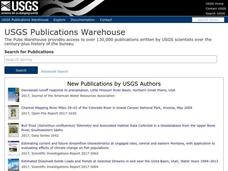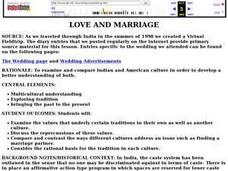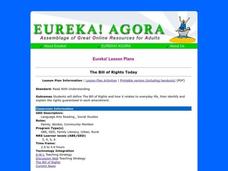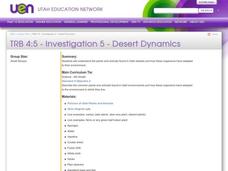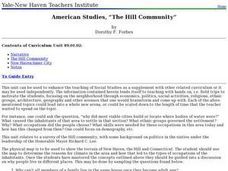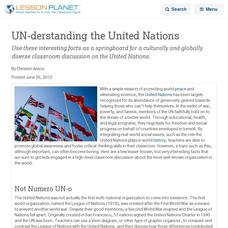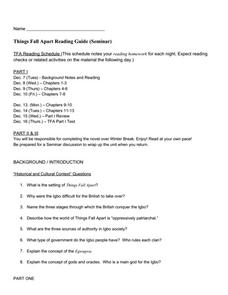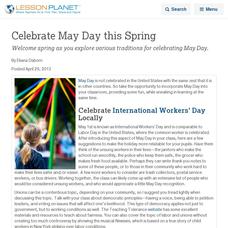Curated OER
Permutations
In this permutations instructional activity, 6th graders solve and complete 5 different types of problems. First, they write a simple conceptual art plan with no more than 3 instructions. Then, students use graph paper and a pencil to...
Curated OER
A Magnetic Personality
Fifth graders experiment to discover how many paper clips different types of magnets can pick up. They make predictions, carry out the experiment and collate the data.
Curated OER
What's Going to Happen at Any Given Barometer Reading?
Fourth graders brainstorm a list of words associated with weather. In groups, they sort the words into categories and observe the weather in their area for a month. To end the lesson, they compare the barometer measurements for a...
Curated OER
What do Maps Show?
Seventh graders practice reading maps. In this geography instructional activity, 7th graders compare a topographical map to a picture of the actual place.
Curated OER
Love And Marriage
Fourth graders examine and compare Indian and American culture in order to develop a better understanding of both.
Curated OER
Why Do You Live Where You Do?
Eighth graders identify reasons why settlers bought land from the railroad and not a Homestead grant. Using that information, they compare and contrast the types of land given in each situation. They discuss the reasons why given...
Curated OER
The Bill of Rights Today
Students examine the Bill of Rights, They read the Bill of Rights and clarify the meaning of the material using different reading strategies. In groups, students brainstorm to compare and evaluate their conclusions with those of others.
Curated OER
What It Is, What It Isn't
Third graders classify and sort different types of beans to be introduced to the classification system in science. As a class, they identify the characteristics of living and non-living organisms and make a chart in their journal to ...
Curated OER
Centennial: Home Sweet Home
Fourth graders examine the various types of homes made by Native Americans. In groups, they compare and contrast their homes to those of the Native Americans and discuss how homes reflect one's culture. To end the lesson, they read...
Curated OER
Pie Crust Experiment
This experiment can be used as a pre-assessment to see what experience and knowledge the high schoolers have in preparing pies. They identify the difference in taste, flavor, texture and appearance as they substitute different...
Curated OER
Desert Dynamics
Fourth graders examine the various types of plants and animals found in the deserts of Utah. In groups, they discover how the plants and animals have adapted to the harsh environment. To end the lesson, they compare and contrast the...
Curated OER
Castles and Forts of Wales and Oregon
Learners compare a castle in Wales to a fort in Oregon and design and build a castle or fort. In this structure study instructional activity, students complete activities to study castles in Wales to forts in England. Learners then...
Curated OER
Mapping the changes in Canada's population
High schoolers find and analyze data found in the census. They compare the population from 1996 to 2001. They explore the type of data they can find in the Census of Population.
Curated OER
Match the Environment Group with the Correct Sector
Students identify different types of environmental organizations. They connect each organization to one of three economic sectors. They examine how each organization is different in their goals and purposes.
Curated OER
For All Time
Young scholars explore the oldest building in their community, then if any have gargoyles. They explore the date of the buildings and what types of materials were used to build the building.
Curated OER
Unit on Globalization and Foreign Investment
Twelfth graders examine the role of investment in an economy. They compare and contrast the different types of foreign investments. They also examine the differences between foreign direct investments and foreign portfolio investments.
Curated OER
Social Studies: The Connecticut Hill Community
Learners discover the reasons for the settlement of the Connecticut Hill Community. Through an examination of the climate, occupations of the inhabitants, and demographics, they discuss reasons people choose locations for settlement. ...
Curated OER
S-O-I-L Soil
Fifth graders research soil, its nutrients, and plant growth. In this soil lesson, 5th graders create soil journals, trace flowers, and include nutrient information on each petal. Students read an excerpt from "McBroom Tells the Truth."...
Curated OER
UN-derstanding the United Nations
Use these interesting facts as a springboard for a culturally and globally diverse classroom discussion on the United Nations.
Curated OER
I Heard the Owl Call My Name
Eleventh graders write a two to three page paper addressing one of the following topics: Analyze the values and beliefs of the two conflicting cultures. Explain which values seem to dominate within the conflict and why. They brainstorm...
Advocates for Human Rights
The Rights of the Child
Don't be fooled by the size of the resource: these few pages provide the blueprint for a substantial, thoughtful unit on children's rights and the different philosophies and approaches that the United States and other countries have...
Curated OER
Things Fall Apart Reading Guide
Chinua Achebe’s Things Fall Apart can present challenges even for experienced readers. Here’s a schedule and corresponding guide that will help readers focus on and record important events. The packet includes fact-based, interpretative,...
Curated OER
Brillant, Beautiful Bats!
Students use the internet to gather information on bats. They write their own bat poem and describe the differences between the parts of a bat's body. They identify how bats are important to humans and how they control the insect...
Curated OER
Celebrate May Day this Spring
Welcome spring as you explore various traditions for celebrating May Day.





